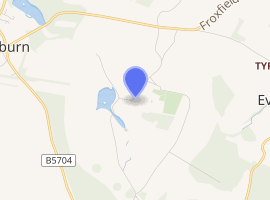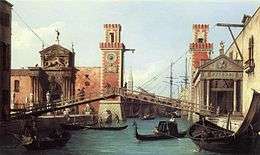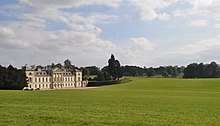Woburn Abbey
Woburn Abbey (/ˈwoʊbərn/),[n 1][3] occupying the east of the village of Woburn, Bedfordshire, England, is a country house, the family seat of the Duke of Bedford. Although it is still a family home to the current duke, it is open on specified days to visitors, along with the diverse estate surrounding it, including the historic landscape gardens and deer park (by Humphry Repton), as well as more recently added attractions including Woburn Safari Park, a miniature railway and a garden/visitor centre.
| Woburn Abbey | |
|---|---|
 The west front of Woburn Abbey | |

| |
| General information | |
| Type | Stately home |
| Location | Woburn, Bedfordshire |
| Country | England |
| Coordinates | 51.9831°N 0.5968°W |
| Owner | Duke of Bedford |
Listed Building – Grade I | |
| Designated | 22 October 1952 |
| Reference no. | 1114006[1] |
National Register of Historic Parks and Gardens | |
| Designated | 30 November 1986 |
| Reference no. | 1000364[2] |
Pre-20th century
Woburn Abbey, comprising Woburn Park and its buildings, was set out and founded as a Cistercian abbey in 1145.[4] Taken from its monastic residents by Henry VIII and given to John Russell, 1st Earl of Bedford, in 1547, it became the seat of the Russell family and the Dukes of Bedford, who demolished the original abbey building and built their house on the monastic site, although the name Abbey was retained. The Abbey was largely rebuilt starting in 1744 by the architects Henry Flitcroft and Henry Holland for the 4th Duke.[4] Anna Russell, Duchess of Bedford, originated the afternoon tea ritual in 19th-century England.[5][6]
In April 1786 John Adams (the future second President of the United States on tour with Thomas Jefferson—who would serve as his vice-president before becoming President himself) visited Woburn Abbey and other notable houses in the area. After visiting them he wrote in his diary "Stowe, Hagley, and Blenheim, are superb; Woburn, Caversham, and the Leasowes are beautiful. Wotton is both great and elegant, though neglected".[7] However in his diary he was also damning about the means used to finance the large estates, and he did not think that the embellishments to the landscape, made by the owners of the great country houses, would suit the more rugged American countryside.[7]
World War Two
From 1941 Woburn Abbey was the headquarters of the secretive Political Warfare Executive (PWE) which had its London offices at the BBC's Bush House.[8]
1945 to 1970s
.jpg)
Following World War II, dry rot was discovered and half the Abbey was subsequently demolished. When the 12th Duke died in 1953, his son the 13th Duke was exposed to heavy death duties and the Abbey was a half-demolished, half-derelict house. Instead of handing the family estates over to the National Trust, he kept ownership and opened the Abbey to the public for the first time in 1955. It soon gained in popularity as other amusements were added, including Woburn Safari Park on the grounds of the Abbey in 1970. Asked about the unfavourable comments by other aristocrats when he turned the family home into a safari park, the 13th Duke said, "I do not relish the scorn of the peerage, but it is better to be looked down on than overlooked."
1970s to present
The 13th Duke moved to Monte Carlo in 1975.[9] His son Robin, who enjoyed the courtesy title Marquess of Tavistock, ran the Abbey with his wife in his father's absence.
In the early 1990s, the Marquess and The Tussauds Group planned to turn the Abbey into a large theme park with the help of John Wardley, creator of the roller coasters "Nemesis" and "Oblivion". However, Tussauds bought Alton Towers and built one there instead.
From 1999 to 2002, the Marquess and the Marchioness, the former Henrietta Joan Tiarks, were the subjects of the Tiger Aspect Productions reality series Country House in three series, totalling 29 episodes, which aired on BBC Two. It detailed the daily life and the business of running the Abbey.[10] It inspired several Monarch of the Glen storylines.
The Marquess of Tavistock became the 14th Duke on the death of his father in November 2002 in Santa Fe, New Mexico, United States. The 14th Duke was the briefest holder of the Dukedom and died in June 2003.
On the death of the 14th Duke, his son Andrew became the 15th Duke, and he continues his father's work in running the Woburn Abbey Estate. The building is listed in the highest category of architecture at Grade I.[1]
Collection
The art collection of the Duke of Bedford is amongst the finest in private hands, and encompasses a wide range of western artwork. The holdings comprise some 250 paintings, including works by Rubens, Van Dyck, Canaletto and Velasquez. Moreover, the collection encompasses examples of the most expensive manufacturers of furniture, French and English in many periods, and a diverse collection of porcelain and silverware.[2]
Paintings

Dutch School
- Asselyn, Jan – 1 painting
- Cuyp, Aelbert Jacobsz – 5 paintings
- Delen, Dirk van – 1 painting
- Flinck, Govert – 1 painting
- Goyen, Jan van – 1 painting
- Potter, Paulus – 2 paintings (A Hawking Party, 1653)
- Rembrandt, Harmenszoon van Rijn – 2 paintings (Boaz, 1643 and Self-portrait, 1640)
- Ruisdael, Jacob van – 2 paintings
- Steen, Jan – 2 paintings
- Velde, Willem van de Velde (the Younger) – 1 painting
- Werff, Adrian van der – 1 painting
English School
- Gainsborough, Thomas – 1 painting
- Gheeraerts, Marcus (the Younger) – 2 paintings
- Hayter, Sir George – 4 paintings
- Hoppner, John – 2 paintings
- Knapton, George – 1 painting
- Landseer, Edwin Henry – 2 paintings
- Reynolds, Joshua – 12 paintings
- George Gower – (The Armada Portrait of Elizabeth I, 1588?, one of the greatest English portraits in existence)
Flemish School
- Critz, John de – 1 painting
- Dyck, Anthony van – 10 paintings (Aubert Lemire, Dean of Antwerp, c. 1630)
- Eworth, Hans – 1 painting
French School
- Bercham, Nicholas – 1 painting
- Lorrain, Claude (known as Claude Gellée) – 2 paintings
- Lefebvre, Claude – 1 painting
- Loo, Carl van – 1 painting (Portrait of Louis XV)
- Poussin, Nicolas – 2 paintings
- Vernet, Claude Joseph – 2 paintings
German School
- Holbein, Hans (the Younger) – 1 painting
Italian School
- Batoni, Pompeo – 1 painting
- Canaletto – 24 paintings (View of the Entrance to the Venetian Arsenal, c. 1732 – one of Canaletto's greatest works)
- Ricci, Sebastiano – 1 painting
- Salvi, Giovanni (Il Sassoferrato) – 2 paintings
Spanish School
- Murillo, Bartolomé Esteban – 1 painting
- Velázquez, Diego – 1 painting (Portrait of Admiral Pulido Pareja, Captain General of the Armada Fleet of New Spain)
Books, films and television
CFF produced the film "Five Clues To Fortune" aka "The Treasure At Woburn Abbey" in 1957, starring David Hemmings and David Cameron who married German actress Hildegard Knef 5 years later.

In 1970, Lucio Fulci filmed scenes for A Lizard in a Woman's Skin there. In May 1973, scenes from Coronation Street were set there and featured a cameo by the 13th Duke. He played himself greeting the characters: one of them, Hilda Ogden, was very impressed with the 'Canney-Letty' [sic] (Canaletto) room.[11]
In Anthony Horowitz's 1987 book Public Enemy Number Two, the book's main character Nick Diamond is framed for the theft of the Woburn Carbuncles as part of a plan by two Scotland Yard detectives to imprison him in order to find out the identity of a criminal mastermind known as The Fence—who turns out to be the class teacher who was supervising Diamond and the other children on the school trip to Woburn Abbey.[12]
On July 2, 1977 and again on June 4, 2005 singer Neil Diamond held a concert on the front lawn of the Abbey. The 1977 concert was a part of a television programm broadcast in the United States titled "I'm Glad You're Here With Me Tonight."
In film and television, Woburn Abbey has been used as a filming location for films and programmes including The Iron Maiden (1962), The Flower of Gloster (1967) and Treasure Hunt (1986).[13]
In The Protector's War, a post-apocalyptic alternate history novel by S. M. Stirling, Woburn Abbey serves as a prison for an English knight; the knight is rescued and flees to the Willamette Valley of Oregon in what was the United States of America.
See also
- List of monastic houses in Bedfordshire
- Woburn Place, Woburn Walk, Woburn Square in Central London
- Robert Salmon (1763–1821), architect of many buildings on the Duke of Bedford's estate
Notes and references
- Notes
- Locally until c.1960 referring to the Village or Abbey /wuːbərn/
- References
- Woburn Abbey – Grade I – Historic England. "Details from listed building database (1114006)". National Heritage List for England. Retrieved 14 December 2016.
- Woburn Abbey (Park and Garden) – Grade I – Historic England. "Details from listed building database (1000364)". National Heritage List for England. Retrieved 14 December 2016.
- "Woburn Abbey". Collins Dictionary. n.d. Retrieved 23 September 2014.
- Chisholm 1911, Woburn, England.
- "Woburn Abbey and Gardens". woburn.co.uk.
- "Woburn Abbey". Encyclopædia Britannica.
- Adams & Adams 1851, p. 394.
- "Political Warfare Executive and Foreign Office, Political Intelligence Department: Papers (Ref: FO 898)". Discovery.nationalarchives.gov.uk. The National Archives. 1938–1973. Retrieved 10 August 2017.
- "The Duchess of Bedford" by Nicole Nobody
- "Benidorm Series 1". TigerAspect.co.uk.
- "ITV – Coronation Street". solarnavigator.net.
- "Public Enemy Number Two (Diamond Brother Mysteries): Anthony Horowitz". amazon.com.
- "IMDb: Most Popular Titles With Filming Locations Matching "Woburn Abbey"". IMDb.
References
- Adams, John; Adams, Charles Francis (1851). The Works of John Adams, Second President of the United States: Autobiography, continued. Diary. Essays and controversial papers of the Revolution. The Works of John Adams, Second President of the United States. 3. Little, Brown. p. 394.CS1 maint: ref=harv (link)
Attribution:
- Chisholm, Hugh, ed. (1911). . Encyclopædia Britannica. 28 (11th ed.). Cambridge University Press. p. 767.CS1 maint: ref=harv (link)
Further reading
- Angelicoussis, Elizabeth (1992). The Woburn Abbey Collection of Classical Antiquities, Monumenta Artis Romanae XX. Zabern. ISBN 978-3-8053-1303-2.CS1 maint: ref=harv (link)
External links
| Wikimedia Commons has media related to Woburn Abbey. |
- Official website
- The Woburn Abbey Collection of Classical Antiquities in the Arachne (archaeological database)
- https://web.archive.org/web/20110612053031/http://www.mspong.org/picturesque/woburn_abbey.html
- Map sources for Woburn Abbey
.jpg)